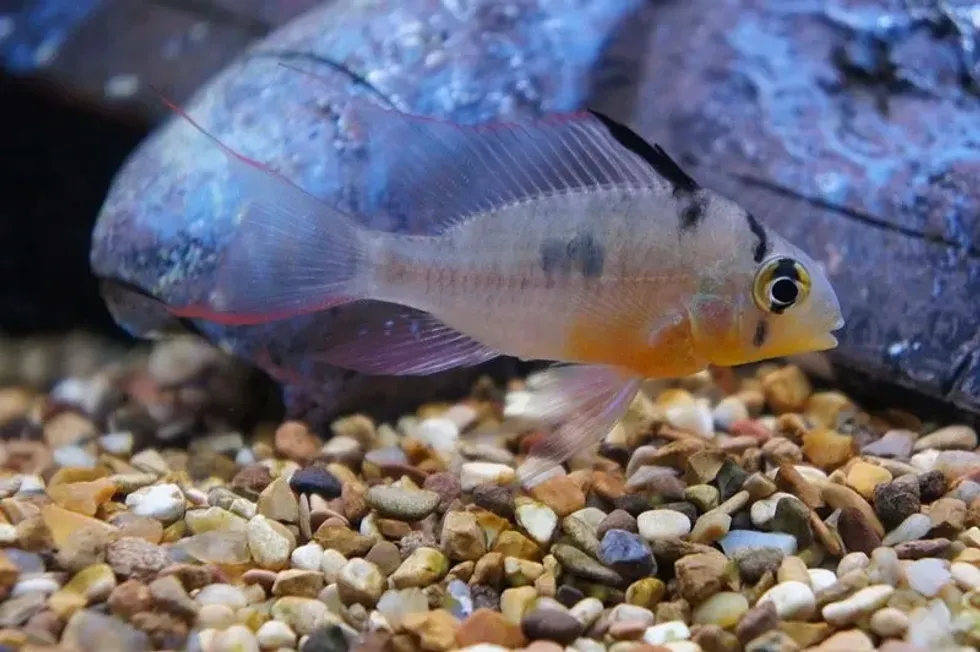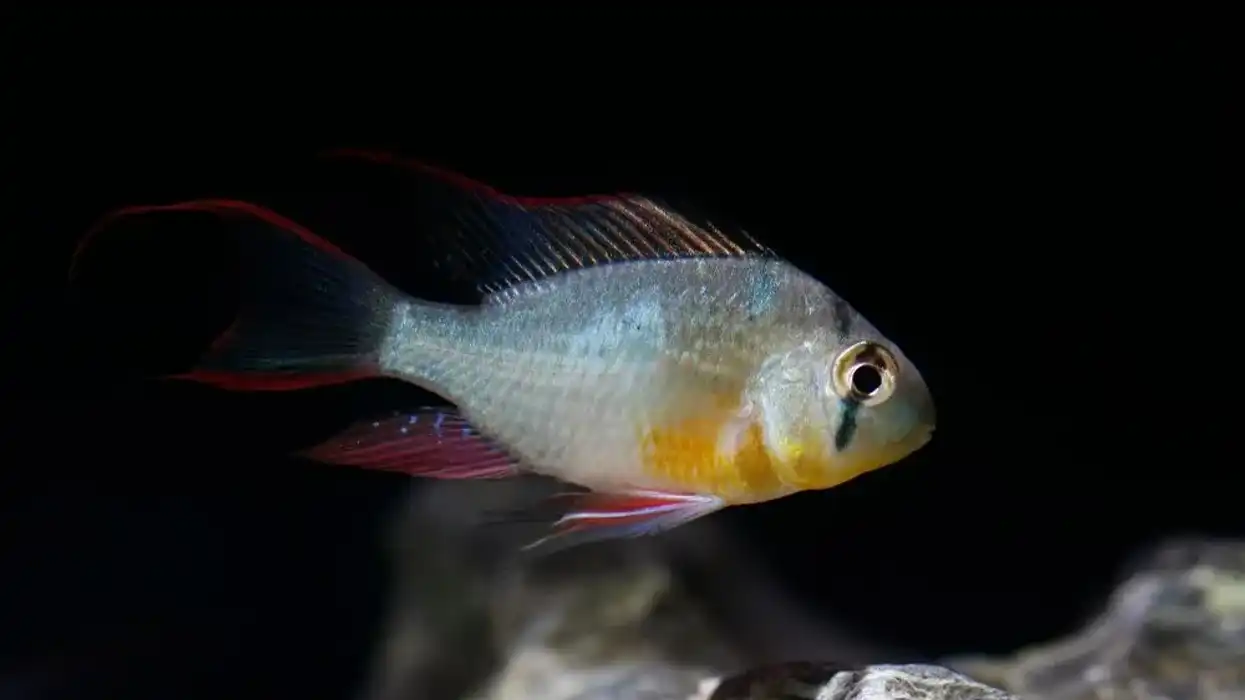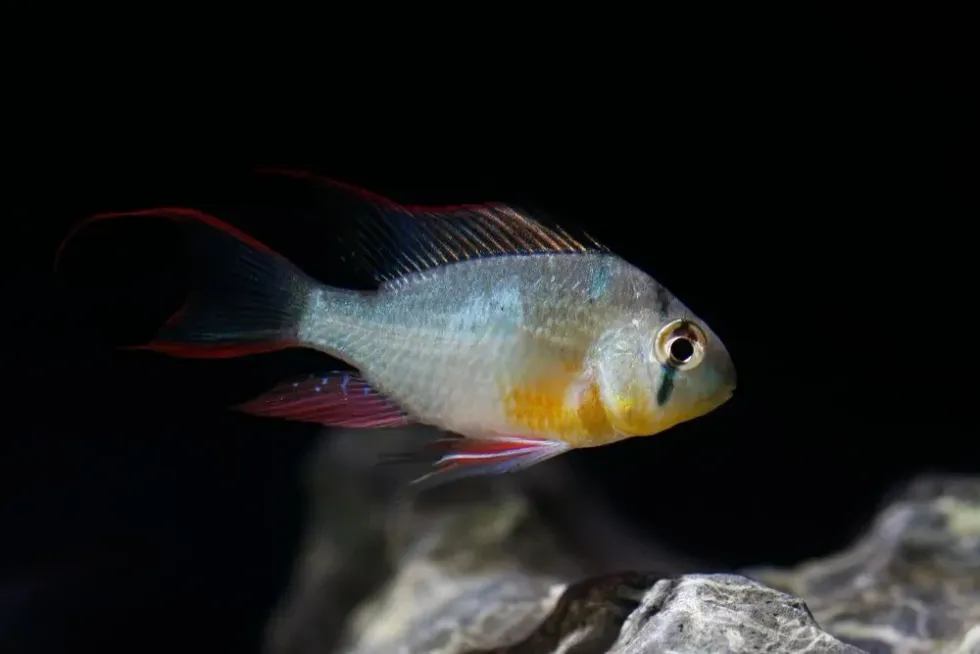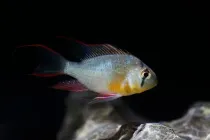Fun Bolivian Ram Facts For Kids
Content
- What type of animal is a Bolivian ram?
- What class of animal does a Bolivian ram belong to?
- How many Bolivian rams are there in the world?
- Where does a Bolivian ram live?
- What is a Bolivian ram's habitat?
- Who do Bolivian Rams live with?
- How long does a Bolivian ram live?
- How do they reproduce?
- What is their conservation status?
- What do Bolivian Rams look like?
- How cute are they?
- How do they communicate?
- How big is a Bolivian ram?
- How fast can a Bolivian ram swim?
- How much does a Bolivian ram weigh?
- What are the male and female names of the species?
- What would you call a baby Bolivian ram?
- What do they eat?
- Are they aggressive?
- Would they make a good pet?
- Did you know...
- Having your own Bolivian ram
- How to tell if a Bolivian ram is male or female?
Bolivian rams (Mikrogeophagus altispinosus) are omnivorous freshwater fish that feed on flash-frozen tubifex, bloodworms, worms, and shrimp.
Residing in the Amazon River basin, these peaceful freshwater fish have their habitat in the waters of two nations. This tropical fish is most often found in Bolivia, as their name implies, as well as in the freshwaters of Brazil.
These eye-catching freshwater fish, also known as ruby crown cichlid fish and the Bolivian butterfly, are in demand in both the fishing and aquarium world.
These tropical fish are easy to care for, and with their distinctive energies, they can bring a playful vibe to any aquarium. Bolivian ram care, especially when it comes to aquariums, should always be left to experienced hands.
Bolivian rams, also known as Mikrogeophagus altispinosus, South American cichlids, or peaceful fish, are very social fish that are always seen in their lifelong pairs. The caudal and dorsal fins of Bolivian rams have red highlights, while the anal and pelvic fins have a turquoise coloring.
There is a black spot that runs from the top of their eye to the bottom of their head.
The minimum tank size needed for a Bolivian ram fish is 30 gal (170 L). The size of this tank is crucial as these lovely fish need an environment that consists of well-arranged plants and a lot of free swimming space.
Smooth pebbles and cave-like arrangements with many resting and hiding places would be great for Bolivian ram cichlids.
They make a fantastic addition to any tank aquarium as they are peaceful fish that get along very well with other peaceful fish. Bolivian rams are egg layers that are like water with mild to medium hardness, a neutral pH, and slightly warmer temperatures.
The water changes to create a natural environment for these fish, which can also be done by supplementing with peat.
Females lay around 220-340 eggs every time they breed, and they like to lay these eggs on rocks. Bolivian ram's young are reared both by the male and female fish, and they have been seen storing these eggs in their mouths to shield them, much like mouthbrooders.
If you enjoyed our article on the Bolivian ram, do also go through our articles on other species like the cichlid and tang fish.
Bolivian Ram Interesting Facts
What type of animal is a Bolivian ram?
This tropical fish belongs to the Cichlidae family and the Geophaginae subfamily. Bolivian butterfly, Bolivian ram, Bolivian ram cichlid, and ruby crown cichlid are all common names for this aquarium species.
What class of animal does a Bolivian ram belong to?
Mikrogeophagus altispinosus are dwarf cichlids that belong to the class of Actinopterygii.
How many Bolivian rams are there in the world?
No census has ever been conducted regarding the exact number of this species.
Where does a Bolivian ram live?
These dwarf cichlids (Mikrogeophagus altispinosus) can be found in Bolivia and Brazil. Bolivian ram cichlid species have also been observed in the upper Rio Madeira catchment area of Bolivia. The fish are often found in small, sandy ponds with water temperatures of around 27°C (81°F).
What is a Bolivian ram's habitat?
These fishes are endemic to the upper Rio Madeira basin of Bolivia and Brazil. While nothing is known about the Bolivian ram's precise environment, it is believed that they live in shallow waters with thick vegetation and open spaces with gently flowing water.
During their breeding season, they prefer areas with smooth rocks and natural caves.
Their natural habitat consists mainly of sandy bottoms with a few clean flat rocks thrown in for good measure. Almost 400 separate fish species inhabit these same environments, and Bolivian rams are used to being in the presence of other fish as long as there is enough room to hide and swim.
Who do Bolivian Rams live with?
Bolivian rams (Mikrogeophagus altispinosus) like to congregate in small groups. They work well individually, in pairs, and groups. If you want to breed these fishes it is best to gather a group of four to eight and allow them to pair off before separating the couples.
How long does a Bolivian ram live?
Bolivian rams lifespan is around four years on average. Their longevity, like that of any other fish, is determined by a variety of factors. Their lifespan can be shortened drastically by poor water quality or an insufficient habitat. To make these fish live long and happy lives, they need excellent treatment, high-quality water, and a stress-free climate.
How do they reproduce?
Bolivian rams (Mikrogeophagus altispinosus) are open-spawning, biparental cichlids. There is no information on the reproduction of the Bolivian ram pair in the wild, but, in captivity, courtship is considered to include head tossing, quivering, and the preparation of reproduction sites.
These behaviors are often carried out by male Bolivian ram cichlids and can last around 48 hours. Following courtship, females lay between 220 and 340 ovoid, brown-colored eggs on the preferred surface, which is usually a flattened stone.
When the female has laid one line of eggs, the male will cross over and fertilizes the eggs.
The female then moves on to the next line, and so on, until all of the eggs have been laid. Parents carry newly hatched fry in their mouths to place them in shallow pits dug by the male during courtship.
Fry are transferred between these pits often. After seven days, the fry starts to become free-swimming and they are then followed around by their parents in a thick school to forage for food.
What is their conservation status?
The conservation status of Bolivian rams (Mikrogeophagus altispinosus) is listed as Least Concern.
Bolivian Ram Fun Facts
What do Bolivian Rams look like?
Bolivian ram dwarf cichlids have a range of subtle physical characteristics. Mikrogeophagus altispinosu fishes have an elongated oval body. Around the pelvic and dorsal fins, the fish are at their widest.
Their form then narrows until it reaches their tail fin. Bolivian ram cichlid has a relatively subdued body color and their coloration is normally tan or silver at the base. Subtle yellow hues near the belly complete the look of these cichlids.
Their head is covered by a broad vertical black stripe that runs over their noses. On certain specimens, faded black streaks can be observed. They pass vertically down the length of the body, much like the head stripe.
There are several unique color designs on the fins as well. The fins of all Bolivian rams are rayed. Rigid rays are used to defend against predators. When swallowed, the rays are sharp enough to pierce the interior of a predator's mouth.
They also aid in improving water agility. A thin black band runs down the front of the dorsal fin. The vivid red edging, on the other hand, adds a splash of color.
This red edging is also visible on the tail fin. Red colors are more subtle on the anal and pelvic fins of the butterfly ram cichlid. They're complemented by soft pearly blue stripes.
Males and females have distinct physical characteristics. Females are typically taller than males. Furthermore, male dorsal fins are often elongated.

How cute are they?
Bolivian rams (Mikrogeophagus Altispinosus) are a very cute species.
How do they communicate?
There is not enough evidence about how Bolivian rams communicate, aside from a few common behaviors seen in most fish species.
How big is a Bolivian ram?
When fully grown, a Bolivian ram cichlid (Mikrogeophagus altispinosus) can measure up to 3 in (7.6 cm) in length. Males grow marginally taller, reaching 3.5 in (8.8 cm). This cichlid at 3.5 in (8.8 cm) long, is about 360 times smaller than an average blue whale and double the size of a guppy.
How fast can a Bolivian ram swim?
This species is not the fastest fish out there, and their speed has never been calculated.
How much does a Bolivian ram weigh?
The weight of Bolivian rams (Mikrogeophagus altispinosus) can vary greatly. An average weight range for this species has not yet been calculated.
What are the male and female names of the species?
There is no specific name assigned to the male and female of the Mikrogeophagus altispinosus species.
What would you call a baby Bolivian ram?
Bolivian Ram babies, or eggs, are called Bolivian ram fry. Fry is the common term used to refer to juvenile fish.
What do they eat?
Bolivian ram diet consists of a large variety of plant and animal material, and they can sift through sediment for tiny creatures. They will eat any substrate for plant material as well, so they are happy with dry meaty foods in captivity.
Stick to sinking pellets, so they fall to the bottom surface of the aquarium, and brine shrimp and earthworms may also be used to supplement a dry or meat diet. Feeding the fish several times during the day may be required as Bolivian rams have voracious appetites.
Keep the quantity of the meals, though, to a thoughtful minimum. This prevents overfeeding and water contamination.
Are they aggressive?
Bolivian rams are peaceful fishes, but Bolivian ram behavior can sometimes indicate aggressiveness during breeding periods. This aggressive behavior is usually reserved for fish that come too close to the breeding pair of Bolivian rams. Apart from that, these fish will coexist with other peaceful fishes.
Would they make a good pet?
Bolivian rams are brightly colored, peaceful, and easygoing. They can be very shy and will not bother the other fish in your aquarium, making them ideal for a group fish tank.
This fish will brighten up your tank with their vibrant colors and amusing swimming habits. Bolivian rams would surely stand out in your tank, with colors ranging from yellow to red and silvery blue.
Bolivian ram tank sizes should not be too small, and experts have stated that a 20 gal (90 l) tank should do, but a 30 gal (136 l) tank is what is ideal. That said, keeping Bolivian rams in a community aquarium makes for a great addition to that environment.
Bolivian rams are an excellent choice for community aquariums as tank size is important. Mikrogeophagus altispinosus have a peaceful temperament and will falter in the presence of hostile fish.
So this peaceful cichlid can be housed in the same tank as fish like dwarf gouramis, silver dollars, Emperor tetras, rummy-nose tetras, guppies, plecostomus, corydoras catfish, platies, tiger barbs, Odessa barbs. They are ordinarily quite reserved and do not communicate too much with their tank mates.
Size is the most important consideration when selecting tank mates for them. If the tank mates are tiny, they can be mistaken for prey and eaten.
When considering adding non-fish inhabitants, size is important once again. Tiny shrimp-like cherry shrimp may be mistaken for a meal by Bolivian rams, but larger species of shrimp-like the amano, bamboo, or ghost shrimp are perfect.
Did you know...
Rams form a pair bond while spawning. Bolivian rams are open substrate spawners, and both parents consciously and vigorously guard their young. Depending on the mood, the color of these cichlids will change.
Having your own Bolivian ram
Bolivian rams are fantastic fish that are not hard to keep, and you can keep between two and eight Bolivian rams in an aquarium tank with great ease. They do well alone, as well as in pairs or groups, and can be paired with other friendly fish as well.
Bolivian rams are solid fish that can be stable and comfortable as long as they have clear and well-oxygenated water. Nevertheless, certain parasitic, bacterial, and fungal infections can make their way into your aquarium. But, white spot diseases, where a parasite causes white spots on the fish's skin, are an uncommon concern.
Items inserted into the tank can also cause parasites and infections, so owners should quarantine and properly disinfect any new arrival, whether this is vinegar eels, aquatic plants, or a new fish species. Every new living addition to the tank should be quarantined, and any new items of decor need a thorough cleaning.
Experts say that the Bolivian ram vs. German blue ram debate is silly as they should be included in the same tank. The combination of the Bolivian blue ram and its smaller German cousin makes the tank look very vibrant indeed.
How to tell if a Bolivian ram is male or female?
It is a tough task to identify the Bolivian ram male vs. female Bolivian ram, and the best way to tell is to see them spawn. However, there are a few variations based on generalizations and anecdotal data.
Males are significantly lighter and have a tapered back, while females point downwards more prominently and are noticeably larger. You can also see a variation in the length and appearance of the pelvic fins, which can be an indicator.
Here at Kidadl, we have carefully created quantities of interesting family-friendly animal facts for everyone to discover! Learn more about some other fish including tetra or giant oarfish.
You can even occupy yourself at home by drawing one of our Bolivian ram coloring pages.
We Want Your Photos!
More for You
See All
Bachelor of Commerce specializing in Accounting and Finance, Master of Business Administration

Divya RaghavBachelor of Commerce specializing in Accounting and Finance, Master of Business Administration
With a diverse range of experience in finance, administration, and operations, Divya is a diligent worker known for her attention to detail. Born and raised in Bangalore, she completed her Bachelor's in Commerce from Christ University and is now pursuing an MBA at Narsee Monjee Institute of Management Studies, Bangalore. Along with her professional pursuits, Divya has a passion for baking, dancing, and writing content. She is also an avid animal lover who dedicates her time to volunteering for animal welfare causes.
Disclaimer
1) Kidadl is independent and to make our service free to you the reader we are supported by advertising. We hope you love our recommendations for products and services! What we suggest is selected independently by the Kidadl team. If you purchase using the Buy Now button we may earn a small commission. This does not influence our choices. Prices are correct and items are available at the time the article was published but we cannot guarantee that on the time of reading. Please note that Kidadl is a participant in the Amazon Services LLC Associates Program, an affiliate advertising program designed to provide a means for sites to earn advertising fees by advertising and linking to Amazon. We also link to other websites, but are not responsible for their content.
2) At Kidadl, we strive to recommend the very best activities and events. We will always aim to give you accurate information at the date of publication - however, information does change, so it’s important you do your own research, double-check and make the decision that is right for your family. We recognise that not all activities and ideas are appropriate for all children and families or in all circumstances. Our recommended activities are based on age but these are a guide. We recommend that these ideas are used as inspiration, that ideas are undertaken with appropriate adult supervision, and that each adult uses their own discretion and knowledge of their children to consider the safety and suitability. Kidadl cannot accept liability for the execution of these ideas, and parental supervision is advised at all times, as safety is paramount. Anyone using the information provided by Kidadl does so at their own risk and we can not accept liability if things go wrong.
3) Because we are an educational resource, we have quotes and facts about a range of historical and modern figures. We do not endorse the actions of or rhetoric of all the people included in these collections, but we think they are important for growing minds to learn about under the guidance of parents or guardians.







